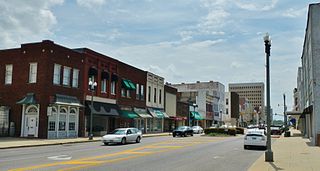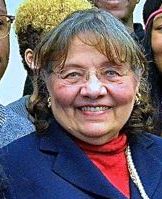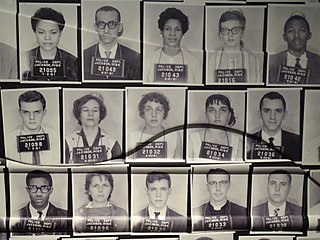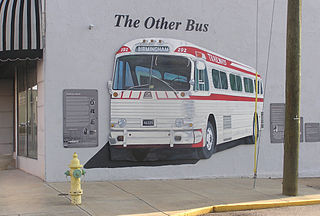
Anniston is the county seat of Calhoun County in Alabama and is one of two urban centers/principal cities of and included in the Anniston-Oxford Metropolitan Statistical Area. As of the 2010 census, the population of the city was 23,106. According to 2019 Census estimates, the city had a population of 21,287.

Theophilus Eugene "Bull" Connor was an American politician who served as Commissioner of Public Safety for the city of Birmingham, Alabama, for more than two decades. A member of the Democratic Party, he strongly opposed the Civil Rights Movement in the 1960s. Under the city commission government, Connor had responsibility for administrative oversight of the Birmingham Fire Department and the Birmingham Police Department, which also had their own chiefs.

Frederick Lee Shuttlesworth was a U.S. civil rights activist who led the fight against segregation and other forms of racism as a minister in Birmingham, Alabama. He was a co-founder of the Southern Christian Leadership Conference, initiated and was instrumental in the 1963 Birmingham Campaign, and continued to work against racism and for alleviation of the problems of the homeless in Cincinnati, Ohio, where he took up a pastorate in 1961. He returned to Birmingham after his retirement in 2007. He worked with Martin Luther King Jr. during the civil rights movement, though the two men often disagreed on tactics and approaches.

Diane Judith Nash is an American civil rights activist, and a leader and strategist of the student wing of the Civil Rights Movement.
Floyd Mann was an American law enforcement official, who served as Director of the Alabama Department of Public Safety between 1959 and 1963. He is best known for his interactions with the Freedom Riders who passed through Alabama in May 1961.

Freedom Riders were civil rights activists who rode interstate buses into the segregated Southern United States in 1961 and subsequent years to challenge the non-enforcement of the United States Supreme Court decisions Morgan v. Virginia (1946) and Boynton v. Virginia (1960), which ruled that segregated public buses were unconstitutional. The Southern states had ignored the rulings and the federal government did nothing to enforce them. The first Freedom Ride left Washington, D.C. on May 4, 1961, and was scheduled to arrive in New Orleans on May 17.

The First Baptist Church on North Ripley Street in Montgomery, Alabama, is a historic landmark. Founded in downtown Montgomery in 1867 as one of the first black churches in the area, it provided an alternative to the second-class treatment and discrimination African-Americans faced at the other First Baptist Church in the city.
Charles Person is an African-American civil rights activist who participated in the 1961 Freedom Rides. He was born and raised in Atlanta, Georgia. Following his 1960 graduation from David Tobias Howard High School, he attended Morehouse College. Person was the youngest Freedom Rider on the original Congress of Racial Equality Freedom Ride. His memoir Buses Are a Comin': Memoir of a Freedom Rider was published by St. Martin's Press in 2021.
William E. Harbour was an American civil rights activist who participated in the Freedom Rides. He was one of several youth activists involved in the latter actions, along with John Lewis, William Barbee, Paul Brooks, Charles Butler, Allen Cason, Catherine Burks, and Lucretia Collins.
Edward Norval "Ed" Blankenheim was an American civil rights activist and one of the original 13 Freedom Riders who rode Greyhound buses in 1961 as part of the Civil Rights Movement, in an effort to desegregate transit systems.

The Old Greyhound Terminal was a bus terminal serving Greyhound Lines located at 1100 New York Avenue NW in Northwest, Washington, D.C. in the United States operating from 1940 to the 1980s. It was used extensively during World War II to transport servicemen, and played a minor role in the Civil Rights Movement. It was saved through the intervention of preservationists. Most of the building was incorporated in the new 1100 New York Avenue high-rise office building when it was built in 1991.
Henry "Hank" James Thomas is an African American civil rights activist and entrepreneur. Thomas was one of the original 13 Freedom Riders who traveled on Greyhound and Trailways buses through the South in 1961 to protest racial segregation, holding demonstrations at bus stops along the way.
This is a timeline of the civil rights movement in the United States, a nonviolent mid-20th century freedom movement to gain legal equality and the enforcement of constitutional rights for people of color. The goals of the movement included securing equal protection under the law, ending legally institutionalized racial discrimination, and gaining equal access to public facilities, education reform, fair housing, and the ability to vote.

The Freedom Riders National Monument is a United States National Monument in Anniston, Alabama established by President Barack Obama in January 2017 to preserve and commemorate the Freedom Riders during the Civil Rights Movement. The monument is administered by the National Park Service. The Freedom Riders National Monument is one of three National Monuments that was designated by presidential proclamation of President Obama on January 12, 2017. The second was the Birmingham Civil Rights National Monument and the third, the Reconstruction Era National Historical Park, was re-designated as a National Historical Park on March 12, 2019.
Frederick Leonard is an American activist who was involved in the civil rights movement.
Catherine Burks-Brooks is an American civil rights movement activist, teacher, social worker, jewelry retailer, and newspaper editor.

The Greyhound Bus Station at 219 N. Lamar St., Jackson, Mississippi, was the site of many arrests during the May 1961 Freedom Rides of the Civil Rights Movement. The Art Deco building has been preserved and currently functions as an architect's office.
Dion Tyrone Diamond is an American civil rights activist.

On 14 May 1961, during the American Civil Rights Movement, a mob bombed a bus filled with civil rights Freedom Riders when two buses were setting out to travel the south in protest of their civil rights following the Supreme Court case saying bus segregation was unconstitutional.

On 14 May 1961, during the American Civil Rights Movement, a mob of Ku Klux Klan members attacked civil rights Freedom Riders in Birmingham, Alabama after two buses were setting out to travel the south in protest of their civil rights following the Supreme Court case saying bus segregation was unconstitutional.
















